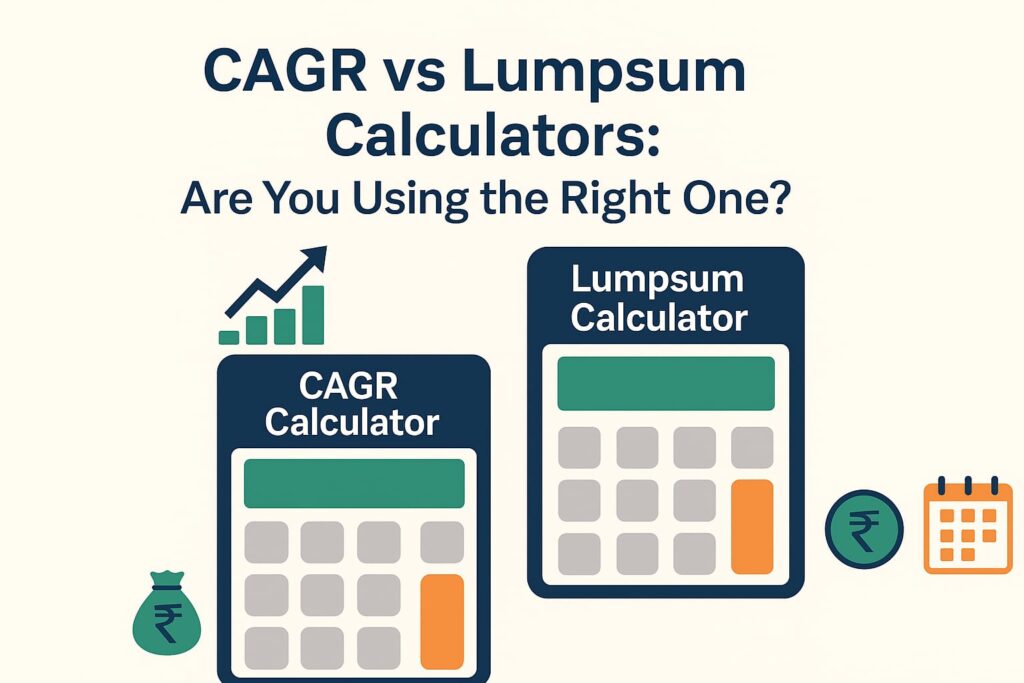Have you ever questioned how your investments are really performing or how much they might grow in the future? Many investors lean on instinct or hearsay, but smart investing today demands a clearer understanding of your returns. That’s where tools like the CAGR (Compound Annual Growth Rate) and lumpsum investment calculators prove invaluable. In this article, we’ll explore what these tools are, the advantages they offer, and how to use them effectively to maximise your investment gains.
What is a CAGR Calculator?
A Compound Annual Growth Rate CAGR Calculator calculates the average annual return of an investment over a set time period, assuming all earnings are reinvested each year. Unlike a simple average, CAGR smooths out volatility, providing a clearer view of actual long-term performance.
To determine CAGR, you need:
- Initial investment
- Final investment value
- Number of years
The output is a steady annual rate that would result in your final amount.
Benefits:
- Clear Performance Insight: Accurately reflects how much your investment grew.
- Comparative Tool: Allows easy comparison across various investments.
- Long-Term Focus: Ideal for assessing mutual funds, stocks, or overall portfolios.
CAGR is particularly useful when returns are inconsistent, offering a way to focus on the overall growth trend.
What is a Lumpsum Calculator?
A lumpsum calculator helps estimate the future worth of a one-time investment over a chosen duration, using compound interest. Enter your investment amount, the investment duration, and your expected annual return, and the calculator will display the maturity value.
Benefits:
- Goal-Oriented Planning: Perfect for planning retirement, education, or large purchases.
- Simplicity: No need for complex calculations.
- Clarity: Provides a straightforward picture of long-term wealth accumulation.
This tool is particularly beneficial when you’re aiming for specific financial targets.
How to Maximise Investment Returns Using the CAGR Calculator
Utilising a CAGR calculator can elevate how you manage investments:
- Evaluate Portfolio Performance- If you invested ₹1,00,000 and it grew to ₹1,76,000 in 3 years, the CAGR would be about 20.9%, revealing your investment’s efficiency despite fluctuations.
- Compare Multiple Investments- Compare CAGR across different mutual funds or stocks to pinpoint consistent performers. Knowing what is NAV in mutual fund also helps, as it directly influences returns.
- Set Realistic Expectations- Past CAGR helps set practical goals. For example, a 12% CAGR in an index fund over 10 years provides a reasonable benchmark.
- Track Progress Regularly- Annual CAGR reviews ensure you’re on track. If growth lags, consider rebalancing your portfolio.
- Optimise Investment Strategy- A persistently low CAGR signals the need for strategic changes to improve returns.
How to Maximise Investment Returns Using the Lumpsum Calculator
Here’s how the lump sum calculator can help with forward planning:
- Plan Around Goals- Need ₹20 lakhs in 15 years? Investing ₹5 lakhs at 11% annually would grow to around ₹23.8 lakhs.
- Adjust Variables for Realism- Try different rates and timelines to find what aligns with your finances, especially in uncertain markets.
- Make Informed Investment Decisions- Base your investments on projected data rather than estimates for more financial clarity.
- Stay Motivated by Seeing Growth- Seeing how your funds compound over time encourages long-term commitment.
- Pair With CAGR for Tracking- When the investment matures, use CAGR to compare actual returns to forecasts—completing the investment cycle.
Smart Tips to Use Both Tools Together
- Use the lumpsum calculator for future planning and CAGR calculator for reviewing past performance.
- Update your calculations annually as market conditions evolve.
- Try different scenarios—conservative to aggressive.
- Integrate with an SIP calculator if you make regular contributions.
These calculators together provide a robust base for smart financial planning.
Mistakes to Avoid When Using These Calculators
- Forgetting to factor in inflation or taxes
- Expecting overly high returns (like 18–20%)
- Using CAGR for short periods under 3 years
- Comparing assets over mismatched timelines
- Believing future performance will mirror past CAGR
Conclusion
CAGR and lumpsum calculators are not just for professionals—they’re tools for anyone serious about managing money wisely. While CAGR reveals past performance, the lumpsum calculator shows future potential. Easily access both through a mutual fund app, enabling smart decisions and better returns whether you’re new to investing or looking to refine your strategy.
- CAGR Calculator vs Lumpsum: Which Grows Wealth?
- Compare CAGR and lumpsum calculators to track returns and plan investments smartly. Learn which tool suits your financial goals best.
- #CAGR Calculator #Lumpsum Calculator #Long-Term Investing #Financial Calculators
Related posts:
 From The First AI Unicorn To The Death Of Angel Tax: The Biggest Highlights For Indian Startups In 2024
From The First AI Unicorn To The Death Of Angel Tax: The Biggest Highlights For Indian Startups In 2024
 Uncommon Symptoms of TB: When Tuberculosis Affects Other Parts of the Body
Uncommon Symptoms of TB: When Tuberculosis Affects Other Parts of the Body
 Winter Park Lawyer: Your Legal Ally in Florida’s Charming City
Winter Park Lawyer: Your Legal Ally in Florida’s Charming City
 A Step-by-Step Guide to Private Limited Registration in Bangalore
A Step-by-Step Guide to Private Limited Registration in Bangalore
 A Step-by-Step Guide to Private Limited Registration in Bangalore
A Step-by-Step Guide to Private Limited Registration in Bangalore
 Rigid Setup Boxes: The Gold Standard in Premium Packaging Excellence
Rigid Setup Boxes: The Gold Standard in Premium Packaging Excellence
 The Ultimate Convenience of Click and Vape of the Technology
The Ultimate Convenience of Click and Vape of the Technology
 Find Your Perfect Leather or Sport Jacket at The Jacket Seller:
Find Your Perfect Leather or Sport Jacket at The Jacket Seller:







